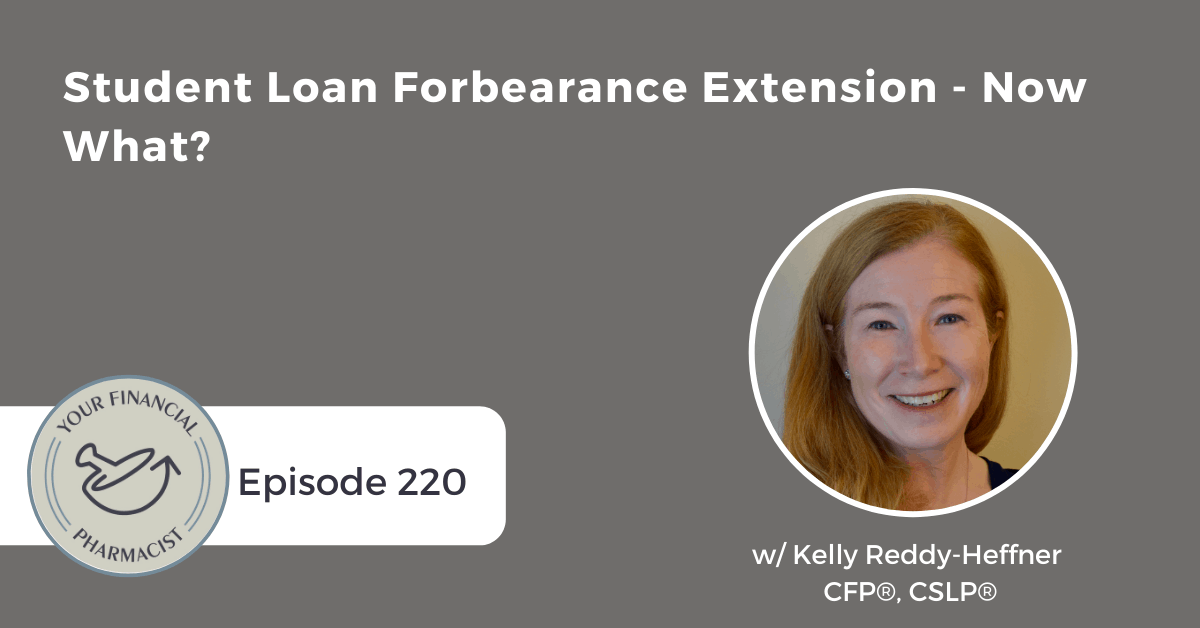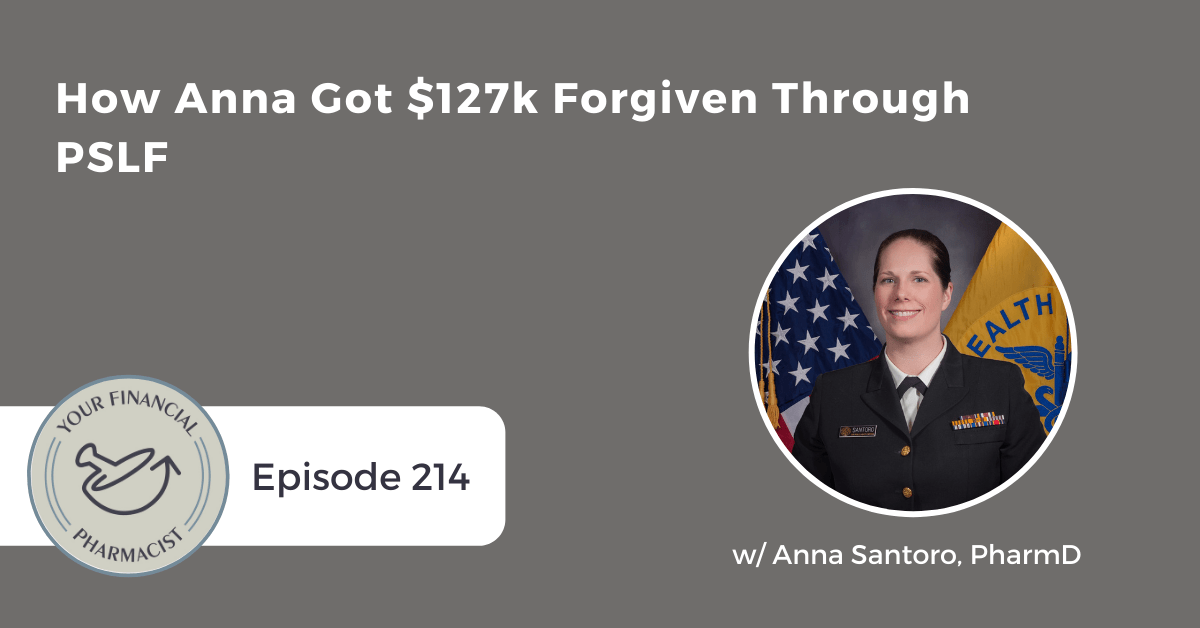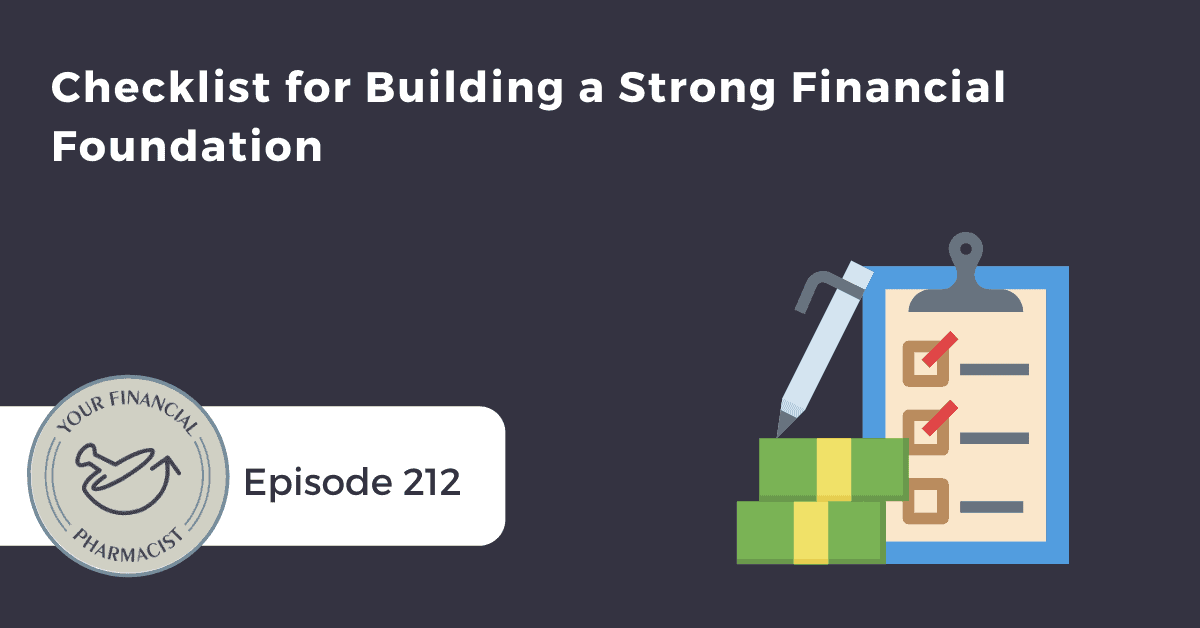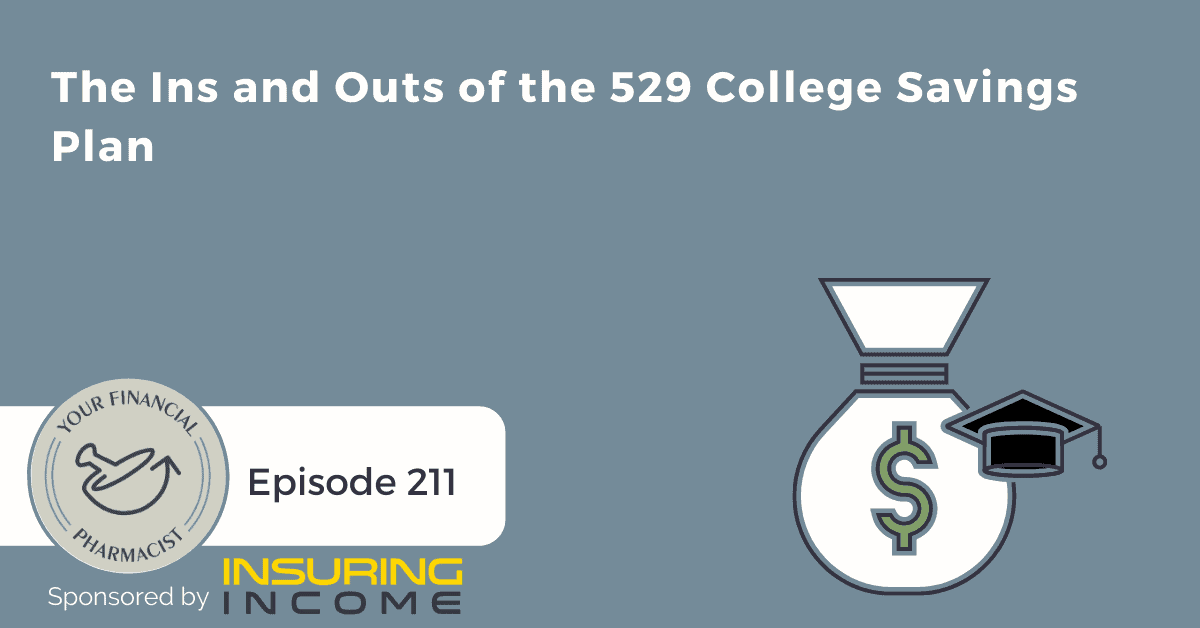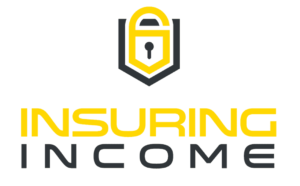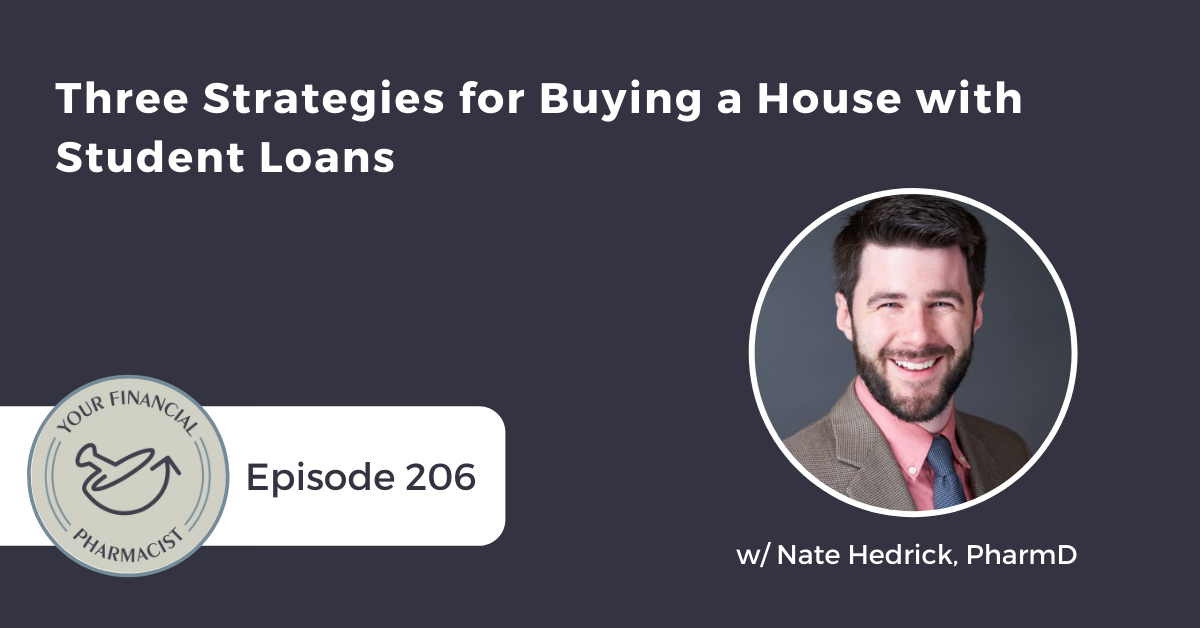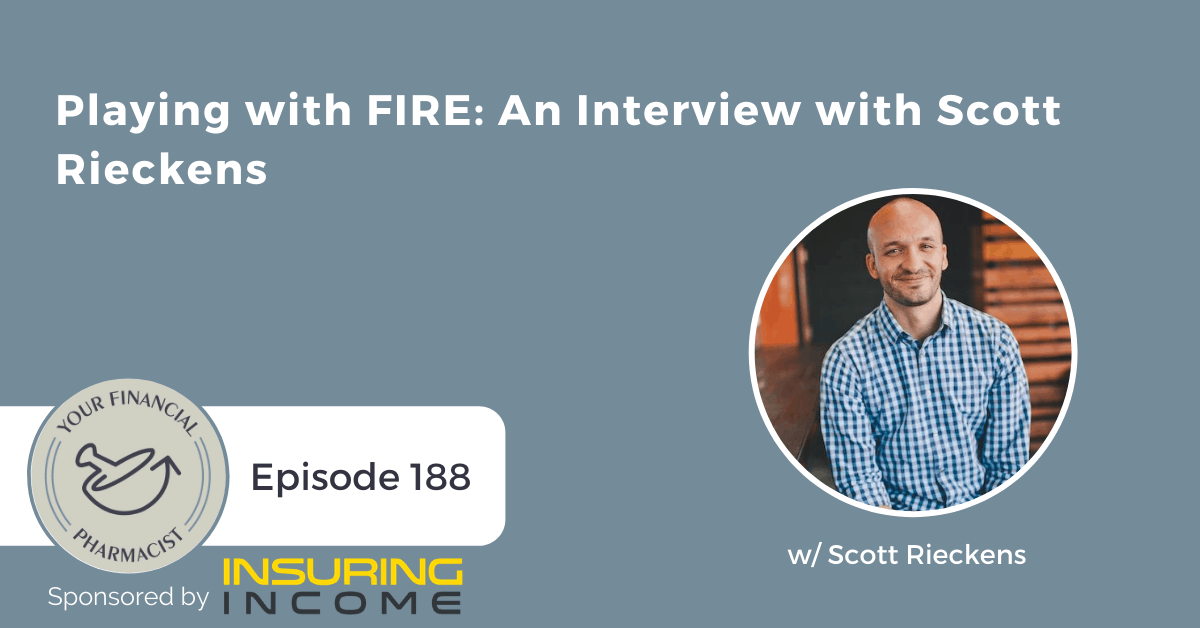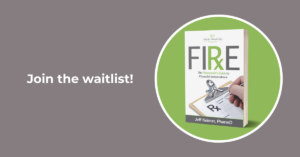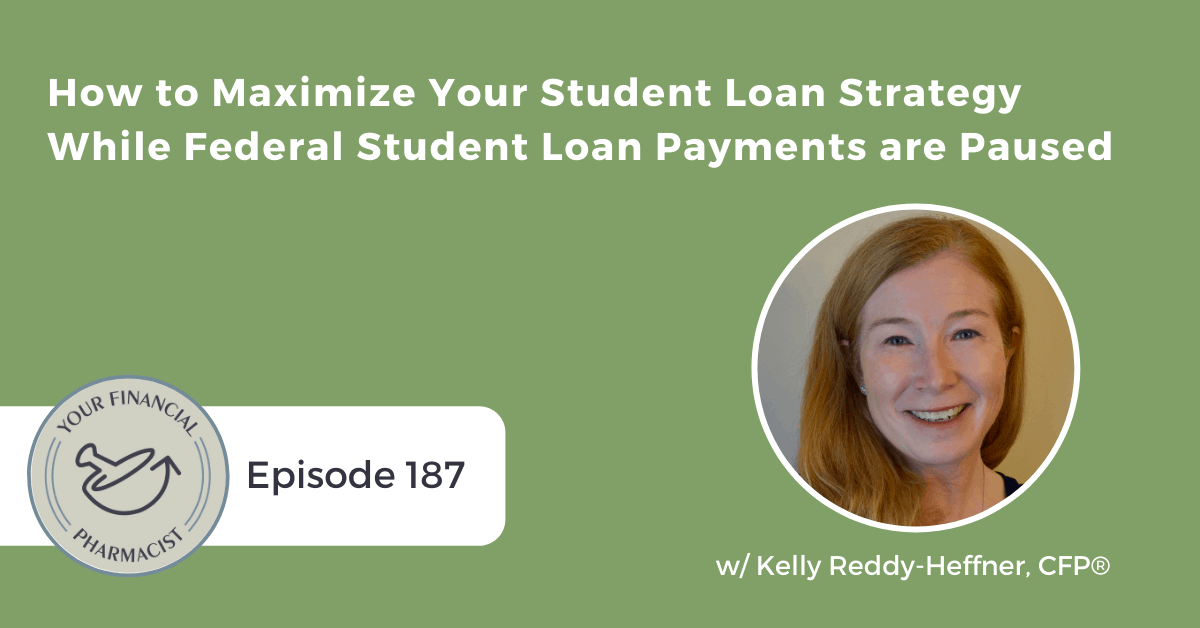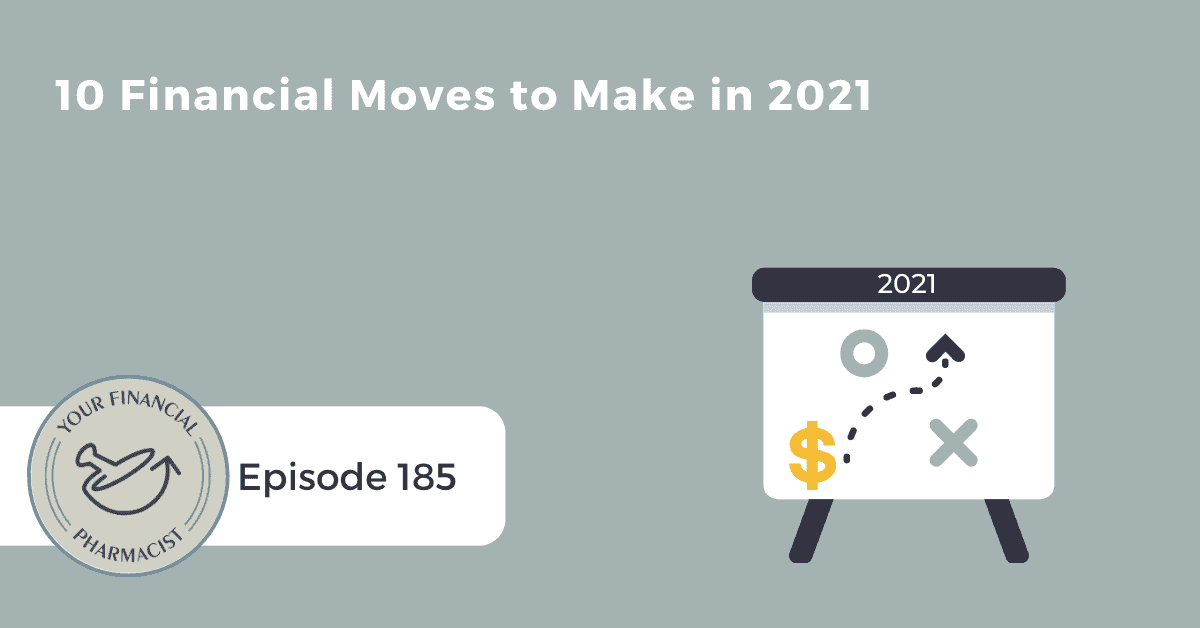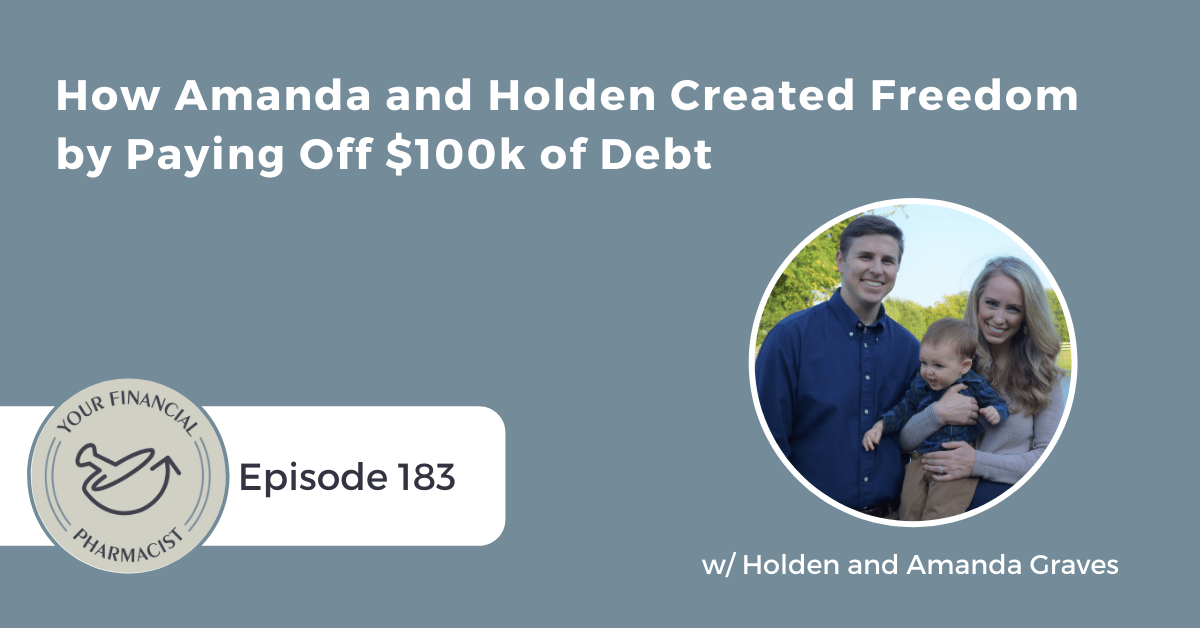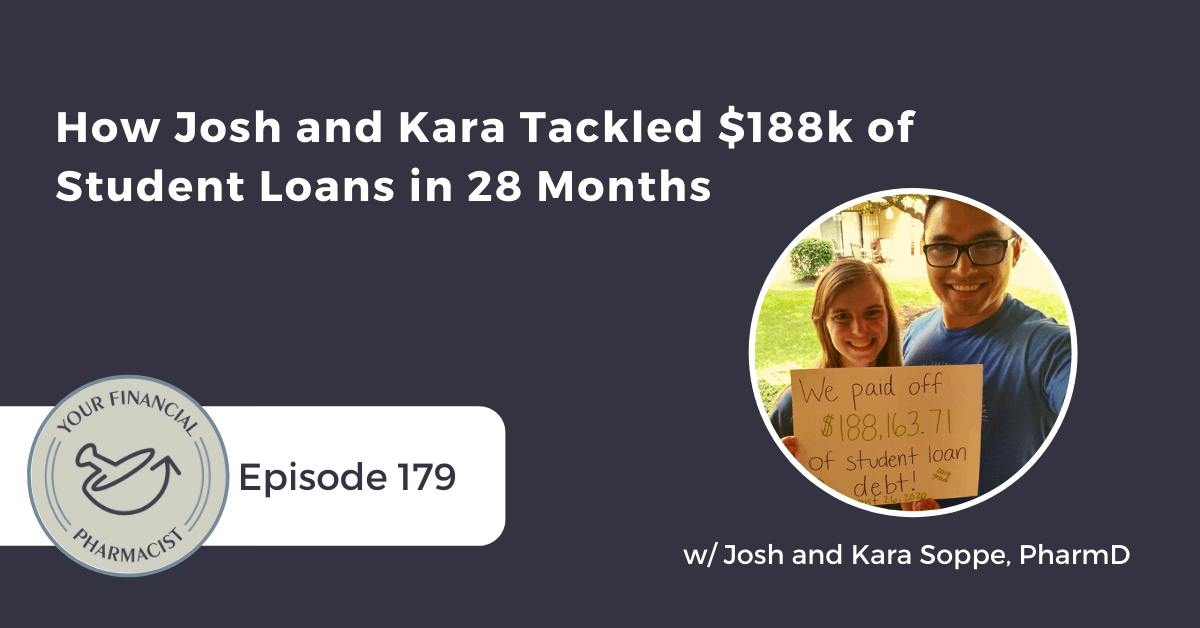Student Loan Forbearance Extension – Now What?
Kelly Reddy-Heffner talks about how those with student loans should be calculating their next moves considering the most recent extension of the administrative forbearance through January 2022.
About Today’s Guest
Kelly Reddy-Heffner is a Lead Planner at YFP Planning. She enjoys time with her husband and two sons, riding her bike, running, keeping after her pup ‘Fred Rogers.’ Kelly loves to cheer on her favorite team, plan travel, and ironically loves great food but does not enjoy cooking at all. She volunteers in her community as part of the Chambersburg Rotary. Kelly believes that there are no quick fixes to financial confidence, no guarantees on investment returns, but there is value in seeking trusted advice to get where you want to go. Kelly’s mission is to help clients go confidently toward their happy place.
Summary
Tim Ulbrich welcomes YFP Planning Lead Planner Kelly Reddy-Heffner back to the show to discuss how those with student loans should be calculating their next moves considering the most recent extension of the administrative forbearance through January 2022. Kelly talks through how to maximize the time left to evaluate your loan repayment options and choose the best next steps for your situation.
Kelly walks through the recent history of administrative forbearance for student loans taking us through to the current and likely final extension set to end at the end of January 2022. During this time of administrative forbearance, recent pharmacy graduates may not have had to make any payments. Others may have allocated the funds elsewhere, new expenses may have arisen, or employment status could have changed. In response, Kelly shares some general advice on making the most of the remaining forbearance period.
The Student Loan Analysis is one way to help pharmacists feel confident with their financial decisions regarding their student loans and to map out realistic goals for repayment regardless of the type of plan. Kelly outlines how the Student Loan Analysis at YFP works, who should consider it, the information to have on hand for your appointment, and where to gather all of your loan details, whether your loans are in the federal or private sector.
Mentioned on the Show
- Learn More About Our 1:1 Student Loan Analysis with a CFP®
- YFP Planning: Financial Planning for Pharmacists
- Register for the Free Webinar: Side Hustling: Extra Ways to Make Money as a Pharmacist
- The Happy PharmD
- YFP 187: How to Maximize Your Student Loan Strategy While Federal Student Loan Payments are Paused
- Coronavirus Aid, Relief, and Economic Security Act (CARES Act)
- Federal Student Aid
- AnnualCreditReport.com
- Get a Free Copy of the YFP Budget Template
- YFP 214: How Anna Got $127k Forgiven Through PSLF
- Federal Student Aid: PSLF Help Tool with EIN Search
- Schedule Your Student Loan Analysis Appointment
- Send in your questions here or to [email protected]
Episode Transcript
Tim Ulbrich: Kelly, welcome back to the show.
Kelly Reddy-Heffner: Thank you, Tim. I am happy to be here.
Tim Ulbrich: It’s been awhile. We had you on last Episode 187, where we talked about how to maximize your student loan strategy while federal student loans payments are paused. And that was back in January 2021, and I think at the time we thought, hey, this whole student loan forbearance thing might be coming to an end soon. And here we are again, talking about this topic and what this pending end to the administrative forbearance means. And so Kelly, kick us off by just bringing the audience up to speed on the background of the administrative forbearance on student loans and the extensions that have recently been extended one last time is what we’ve been told.
Kelly Reddy-Heffner: Absolutely. Right. So nothing has changed and yet it feels like everything has changed at the same time. The perfect feeling. Right, we originally had that administrative forbearance at the start of COVID in March of 2020 by the Trump administration. It was extended once during that presidential administration. And then now, we’ve seen with the Biden administration that it was extended two more times. So we had that extension until September, and now we have what I believe is the final time where we have until January 31. So I do think we’re coming to the end of the forbearance extensions, in my opinion. So we’re going to enjoy a few more months of 0% interest, no loan payments due, and of course those loans not having any default issues. So a couple more months, but we’re coming to the end of it.
Tim Ulbrich: Yeah, and Kelly, you and I were talking before we hit record, I think one of the challenges — and certainly there’s been some benefits during this time period. We know firsthand from many in the community that they’ve been able to through this administrative forbearance accelerate the achievement of other financial goals, and that certainly has been a positive but also coming up on the two-year mark, essentially, right? So March 2020, you know, we entered lockdown, the pandemic, we started the forbearance with the CARES Act. So this time period of two years, I think that presents an interesting challenge where perhaps folks have gotten used to having no student loan payment and perhaps other expenses that have come to be. And then I think about the classes of 2020 and 2021 specifically where student loan payments haven’t even been a thing, you know, for them because of their graduation during this time period. So I suspect, Kelly, that a lot of pharmacists, a lot of folks listening out there, perhaps clients that you’ve been working with, have been wondering, should I or should I not make payments on my student loans during the administrative forbearance? And certainly this is not meant to be and it’s not individual advice, but what are your thoughts on this? And how have you helped coach folks through making this decision?
Kelly Reddy-Heffner: Well, I think you’re right that, you know, two years is a lot of time. So we changed our financial goals and priorities changed considerably, our employment may have changed in that timeframe as well. In general, I think I speak for our podcast listeners that they are proactive. They want to be taking action. They’re listening because they want strategies to put into place. So this has been a very interesting time period. We’re feeling like we’re not doing anything with the student loans. But there are a lot of things that we could be doing in the background, which I think can have a very positive impact on net worth and put our listeners in a great position for when repayment starts again that they’ve accomplished a couple other things. So we’ve been recommending if you are, you know, having any other debts, take care of those. Anything accumulating interest should be a top priority while this federal loan is not accumulating any interest. Building up an emergency fund — so again, we may not see net worth increase because the student loan debt is paid off. But we can see positive changes because those emergency funds are improving and giving people more options and more confidence in their finances. If you are in a PSLF program or a non-PSLF forgiveness program, then we’re not making payments at all on the federal side because there’s no benefit to doing that. But if you are only paying the loans, that is your strategy, you’ve either done the math yourself or spoken to a professional and you know that that is your plan, then that really could be on the agenda. Like if it’s comfortable to make those payments on the federal loans, then that could be an activity as well. But we do need to get back into the mindset of the payments are coming back. So we are asking clients and listeners to know at least a rough idea of what the payment amount is and to bring that back into your budget.
Tim Ulbrich: Great point, Kelly, there. I think it’s time to dust off, re-dust off the budget and really look at — run the calculators, use the tools that are available at studentloans.gov, you know, what is that estimated payment going to be as we get into February 2022? And how does that work or what changes need to be made to the budget to make that work, right? And now is the time to get the practice reps so that we’re not caught off guard in the New Year and we can make some adjustments or changes and have some time to warm up to that. And I think that’s a really important point and perhaps one that folks have been thinking about but dragging their feet on for good reason because of all the talk of the extension and I think I believe, you believe, that this is likely the end of that. And so let’s get ready for those payments to begin at the beginning of February 2022.
Kelly Reddy-Heffner: Agree. I mean, there was a statistic out there that 90% of the over 45 million borrowers were not making payments as of March of this past year. So that is the bulk of borrowers not making those payments. So it is time to figure out what that payment might look like. Like you said, recent graduates, 2020/2021, may have had an income tax return with part of a year in residency or the full year in a residency. So that payment amount could be very low. Once they’ve started full-time employment, income has increased, if they’re on an income-driven repayment plan, that’s what drives what that payment amount is, the income. So that will have potentially changed significantly.
Tim Ulbrich: Yeah, one of the things, Kelly, I often share with new graduates or even students that are beginning to think about student loan repayment is because of the complexity of the options that are out there, both federal and private — and we’re going to come back to that here in a little bit — this is not a decision that you want to wander into. Right? We want to be intentional with understanding those options, we want to be intentional with thinking about how this fits in with the rest of the financial plan. And here we are, we’ve got months to do that, right? So let’s take advantage of this time period, the end of 2021, and let’s really get ready so that we can hit that beginning of repayment when the pause ends and we can be confident with making that decision. And as we’ve talked about on the show before, you know, choosing between Option A v. Option B v. Option C, given the amount of student loan debt that many pharmacists have, that can be very significant in terms of the amount that’s going to come out of pocket because of the nuances with the different repayment plans. So intentionality really matters here. And let’s use this time that we’ve got left before this administrative forbearance ends to make sure that we’re ready in making that decision. Kelly, Step No. 1 — so I’m somebody listening and maybe I’m not loving the energy of this episode and the reality that hey, I’ve got to get back in the game. But I’m listening, I’m ready, and whether I’m a 2020/2021 grad or perhaps I was paying prior to the pandemic and it feels like forever ago and I’ve got to get back in the game, what is the first step that listeners can take to get ready for payments to start back up?
Kelly Reddy-Heffner: Absolutely. Well, again, just knowing what we’re dealing with, like what are the loans? Taking that inventory, you know, understanding which ones are federal, which ones are private, they have very different attributes in terms of what types of options are available for repayment. So we want to know what are we working with? What do we have on the table? And again, I think figuring out some of the other lifestyle goals as well, we cannot ever undervalue like how people feel about the loans, what they really want to accomplish with other goals as well. So you can look at studentloans.gov, which will actually redirect to studentaid.gov, to get some calculators, some information. That also is the source of your NSLDS file for taking that inventory and then pulling your credit report, you can get your free annual credit report and seeing like, OK, what’s federal? What’s private? I think knowing how much you can afford is key too. So sometimes that payment amount is what the payment amount is but knowing what your budget is, what you can afford, will help determine like do you need to be in an income-driven repayment and putting a plan in place? Is refinancing a better option because you have resources available? So again, there are resources out there to assist with this. But it’s a lot of data, a lot of information, a lot of subtle nuances. Even we have to be like, hold on. What is the date of the loan? That sometimes will impact what repayment options are available, just literally the date the loan was taken out.
Tim Ulbrich: Absolutely. And so Step No. 1, you know, if you don’t have that up-to-date information is understanding all of the information about your federal and private loans. What’s the balance? You know, who is servicing those loans on the private side? You know, we should be able to quickly get information on the interest rate and the repayment terms on the federal side right now. That probably is showing as a 0% if those are qualifying under the administrative forbearance. But I love — Kelly, I talked with a couple actually just the other night who when I asked them about their student loans, you know, it was very precise. They had all the information. “I’ve got three federal loans, I’ve got one private loan.” And it was to the penny of the outstanding balance, what they had. And I loved the intentionality of hey, I don’t like the number. I don’t like that it’s $194,000. But I understand that in order to put a plan together and to be able to evaluate the options and to be able to know what we can afford inside the budget, I’ve got to understand what we’re working with first and make sure that we have all the details. Step No. 1 is that inventory. And we’re going to link in the show notes to the links that Kelly mentioned on the federal side and the private side. So the federal side, she mentioned studentloans.gov will redirect to studentaid.gov. And then on the private side, running the credit report at annualcreditreport.com. Kelly, after the inventory, you alluded to the second step, which I think is really important is what can the budget afford? And when I teach this topic of student loan repayment, that’s often something I try to walk folks through is, hey, let’s make sure we know what the budget looks like. And as we’ve said many, many times on this show, student loans, as big as they are for many pharmacists, student loans are one piece of the puzzle. So we’ve got to understand what else is going on, what other expenses are out there, what other goals are out there, so that we can determine what that budget can afford. And if we decide to do a more aggressive repayment path, what does that mean for achieving other goals? If we decide to do something like a forgiveness path or more extended path, what does that mean for achieving other goals and really looking across the financial plan? And so we’ve got a budget template for folks that want to get started or update that budget. If you go to YourFinancialPharmacist.com/budget, you can get a copy of that. And so Step. No. 1 is inventory, Step No. 2 is really looking at what the budget can afford, Step No. 3, Kelly, is probably the most confusing, the most difficult, but the most important part, which is understanding the options. And unfortunately, the hand we have been dealt as borrowers of student loans I would argue is more complex than it probably needs to be. Separate topic for a separate day. But talk to us about understanding repayment options, something you work often with our clients about, and just the magnitude of this decision.
Kelly Reddy-Heffner: Well, right. I mean, once you’re on studentaid.gov and you’re plugging in some data, I mean, you’re going to get a lot of information back about these repayment options, especially on the federal side. I mean, and they, again, range significantly. So even that date you took out the loan can have a significant impact on what options are available. So we have income-driven repayment options, which we have two that we usually recommend or work with in PAYE and RePAYE. Of course we have standard repayment as well, which is usually that 10-year term, which is a fixed payment amount, does not vary with income. We don’t lean towards extended or graduate options, just because they really perpetuate the length of time that it takes to repay the loan and often, you know, with pretty high interest paid in the process. So income-driven is usually the area where we’re operating in and also that standard repayment if we’re not refinancing. And again, just understanding like the date you took out the loan, you’re right that 0% is kind of the default on all of the data, which is hard. Like we were taking out loans when we were 18, 20. It’s not usually the ideal time for being detail-oriented about this type of information. So we can take a look at the dates the loans were taken out in the federal system and see what the interest rate was that year. But it’s a lot — it’s a lot of nuance for sure.
Tim Ulbrich: And then we’ve got, you know, on the federal side, you mentioned the variety of options. To make it a little bit more complicated, we’ve then got the private option. And we’re going to come back to talking about some common questions that we get around refinancing. I do — without going too far down the rabbit hole because we have talked about it extensively on the podcast, most recently on Episode 214, I interviewed a pharmacist who had $127,000 that was forgiven through the Public Service Loan Forgiveness. And so we’ve talked in detail about PSLF, non-PSLF, but I think it’s worth talking about again just briefly in the context as we look at the end of this administrative forbearance. So Kelly, quick dive, I don’t want folks to hear this and think, oh, I’ve got it with PSLF and non-PSLF, certainly more complicated than what we’re going to discuss briefly — but quick dive into PSLF, non-PSLF, what they are, and the main differences between the two of them.
Kelly Reddy-Heffner: Absolutely. And I mean, I think there are still questions. Like it has improved our level of information, but the PSLF rules are very specific. You do need to work for the right type of employer in a nonprofit setting, and you can check an EIN number now in some of the PSLF tools on studentloans.gov, which is helpful. You do need to be in the right kind of loan. So we still see that as a little bit of a problem at times. Like it does need to be in a direct type of loan. So if we see FELL loans, we see HPL loans, we see Perkins, those don’t automatically line up to qualify. And that’s where some of the confusion still exists. You do have to be in the right repayment plan. So in income-driven repayment, there are some nuances with standard repayment that require a little bit of conversation if you’re in standard. You have to make the right amount of payments. It’s 120. And you do need the documentation. So as FedLoan servicer changes to a new servicer, this is an area that we are focusing on and just reminding borrowers to make sure that they have their data documented. Go onto FedLoan, take a screengrab of where your cumulative payments are. Of course the best part is it’s a tax-free situation. In contrast, the non-PSLF forgiveness is a longer time period. So instead of being 10 years, it’s 20-25 years. 20 or 25 depends on some nuances with grad loans and the type of repayment plan that you’re in. And again, it doesn’t matter if you work for a nonprofit. You can have any employer to qualify for non-PSLF forgiveness. It really is based more on the amount of loans compared to income for that program. And then there is a tax consequence at the end. I think that tax consequence is one of the things that maybe will continue to be evaluated by the current presidential administration, like are we keeping that? Are we not keeping that? It would have an impact on people in that program. So yeah, there’s some pretty significant differences between those two programs.
Tim Ulbrich: Kelly, when I talk with folks about non-PSLF and the way I describe these is, you know, PSLF I think is a little bit better known by folks just because it’s gotten so much press and attention, although maybe not the best press. But it feels like folks are more aware and educated. I describe non-PSLF as the lesser-known forgiveness option in the federal system. And I think when I see folks’ reaction, there’s kind of this range of emotion from, ‘Oh my gosh, 20-25 years, like I’ve got a tax bill known as the tax bomb at the end of this, like who in the world would do this?’ Right? And then you start to talk a little bit about, OK, well, depending on the debt load, depending on some of the strategies around this, depending on if we think about saving for that tax bomb, maybe it’s not as overwhelming as it can seem. But certainly that’s a long period of time and, right, there’s some complexities here with the tax piece. So in your conversations with clients at YFP Planning, like does this have a role? How often does this come up? And are folks, you know, worried about some of those things that I just raised in terms of that tax piece as well as the timeline?
Kelly Reddy-Heffner: Yes. I mean, that is a long time to be, you know, in a repayment strategy. So right, we do do an analysis to see like what do the numbers look like? Often, these decisions are very emotional. 20-25 years is a long time. So we try to refocus on the factual components like what does the actual repayment look like? Like how does the payment amount per month compare if you refinance or accelerate a repayment? What is the overall forgiven amount? Sometimes, that number is quite compelling. Like if you are seeing, you know, six-figure digits of what’s forgiven, then we really do have to see like is that a viable option, despite the fact that it can be a little overwhelming to think of a 20-year time span. So yeah, we do carefully look at really all that factual data and then try to talk through the emotions behind it and what it means in terms of other things that you might be able to achieve in that timeframe. Sometimes it does make it much easier to buy your first home, to pay off something else, to be able to meet your monthly budget. Sometimes accelerating repayment is not affordable.
Tim Ulbrich: Yeah, absolutely. And I think this is a good reminder of — and many folks that I’ve talked with I can sense that sometimes, the overwhelming feeling, beyond just the number of the amount of debt they have, is that nagging feeling of like, I know there’s so many options out there, and I’m not sure I understand the differences between them and a desire to feel confident in that understanding and then making a decision that you know has evaluated other parts of the financial plan is ultimately best for their individual situation. And I want folks to not underestimate how important that feeling can be, especially with momentum and the rest of the financial plan, to confidently choose the repayment option that you know has been evaluated and is really best for your personal situation and to hopefully feel empowered and educated throughout that process as well. So Kelly, on the private side, refinancing is a topic that we talk about often on this show. It’s one of the most common questions that I get in terms of should I or should I not refinance? What should I look for in a lender? You know, what are some of the considerations in the refinance process? And I want to hit some of that because I think there’s probably many folks that are listening that maybe refinanced before the pandemic and have been excluded from this administrative forbearance or folks that have delayed refinancing and are wondering like, when might I pull that trigger? You know, thinking about what might or might not happen in interest rates. And so I suspect the conversation around refinancing is going to heat up as we saw the activity around refinancing really at historic levels before the pandemic hit back in January and February of 2020. So first of all, Kelly, what is refinancing? Give us the definition.
Kelly Reddy-Heffner: Absolutely. And it is — the two terms consolidation and refinance are very different. They’re used interchangeably, which is not quite right. So you know, as opposed to consolidation, which is taking federal loans for convenience or to be in a position to be in income-driven repayment or to qualify for forgiveness, consolidation is taking like a bunch of federal loans and putting them into like one or two subsidized or unsubsidized. So still federal, interest rate really is not impacted. It definitely doesn’t lower the rate. It may open up other opportunities for different federal programs. Refinance is either taking your federal loans and moving them into the private sector, which is a one-way transaction. Like once you’ve moved into private, that’s it. Or you have existing private loans and you refinance them into other private loans. So very different, very different what is happening there.
Tim Ulbrich: Yeah, and I think folks are likely somewhat in this holding pattern, right? I think in terms of, as I alluded to just a couple minutes ago, like hey, I think refinancing is the play or perhaps they’ve evaluated that, but what do I do? We’ve got several months left of administrative forbearance, rates may or may not go up, there’s offers that are out there that might help minimize some of that concern. But like what might I be giving up as well? And I think that’s one of the other questions and considerations folks need to be thinking about is what is different? So it’s not identical from the federal side to the private side with refinancing. Important note here is that every private lender can be a little bit different. So you know, we’re generalizing as we’ve put them together. But what are some of those main differences or things that folks need to be looking for as they consider what might be different from what they have in the federal system versus what they’re pursuing in the private market?
Kelly Reddy-Heffner: In order to really evaluate a refinance, usually the primary objective to refinance is interest rate. So if you can get a better interest rate, that can be a compelling reason to refinance. But you’re absolutely right that there are tradeoffs to doing that. So you know, high level, I think there is a little of FOMO, like ‘Oh my gosh, interest rates are low. Are they going to go up in the next week?’ And then this becomes not a viable strategy. We have been monitoring interest rates throughout the summer, and they’ve been pretty steady. Like we’ve even seen them go down a little bit and kind of back up a bit, but pretty steady. We have seen some interesting programs or offers from private lenders where they kind of offer this 0% bridge. That was happening for a bit. In general, you know, the couple big things are with the federal loans, we have seen the protections in action. Like we know there is a very tangible like ah, that is what a federal protection means because of the CARES Act. In general, you know, will the loans be discharged? That’s a big question if something happens to someone. In the federal loan program, they are discharged for death and for disability as well. On the private side, it really depends on the lender. So that is something if we’re working with a client who’s considering a refinance, we are looking at the fine print to see what the discharge status would be. In terms of, you know, can I pay extra towards a refinanced loan or even a federal loan, the answer is usually yes in both cases where you can accelerate some repayment if that’s the appropriate strategy to take. But in general, we don’t have income-driven repayment on that refinance side. So if your income goes down, which you know, is something we hope doesn’t happen to our listeners but occasionally it does either by choice or not by choice, you know, is a job opportunity amazing and you’re willing to take a slight pay decrease? In the federal program, you can provide documentation that your income has gone down and have that income-driven repayment re-evaluated and lowered. That’s not a feature of a private loan system. So the payment is what it is.
Tim Ulbrich: And I think you articulated well there why it’s so important that folks are running the numbers, right? You mentioned the primary goal is to effectively lower the interest rate. And for many folks, that savings can be significant. If you’re talking about $150,000-$200,000+ of debt and you’re seeing a spread of 1-3%, whatever it might be, on interest rates depending on their personal situation, like that math adds up. So what I encourage folks is run the math but don’t stop there, right? Be thinking about these other things. You mentioned some tangible examples we have seen are the benefits of the federal program, the CARES Act being one. Just last week or it might have been the week before, the announcement from the Department of Education about over $5 billion being allocated to those that have a total or permanent disability in terms of loan forgiveness. So again, another tangible benefit and them improving the ease of that forgiveness process for those that have a total and permanent disability. So there are differences, and the savings may be there and often that may make sense, but just make sure you’re also considering some of these other factors as well. So we have I think outlined fairly well that navigating student loan repayment certainly on your own given the factors that we’ve discussed can feel overwhelming. I’ve been there, and I think aside from exit counseling that folks get, there really isn’t a whole lot of assistance in figuring out which repayment option is going to be best for your personal situation. And therefore, folks might get defaulted into the standard 10-year repayment plan or wonder, am I in the best repayment plan for my personal situation? And that is why we developed an offer a custom one-on-one student loan analysis. In this service, the goal is that we’re working one-on-one with you to lay out all your options so that you can confidently choose a repayment plan that hopefully will save you the most money and that ultimately aligns with other financial goals. And so in doing this, you’ll work with one of our YFP Planning Certified Financial Planners to inventory your loans, both federal and private, evaluate eligible repayment options, including the ones we’ve discussed here today, student loan forgiveness, income-driven repayment, private refinancing, and then ultimately try to determine what that best repayment strategy is for your situation. So Kelly, you are the lead for us on conducting these one-on-one student loan analyses. I know it’s something you also do frequently with clients of YFP Planning that are participating in our comprehensive planning services. So talk to us a little bit more about this service, the student loan analysis, and what folks can expect.
Kelly Reddy-Heffner: Well, especially now, as there are so many unknowns, we do struggle with like what is the next best step? And I think we do — I hope — help clients get some clarity. Like sometimes there are options and knowns beyond what we think are available. So I’d say one of the biggest objectives of doing the analysis is putting confidence in a next step. So this is the information we have available. So I think it is an ideal option for any borrower who wants to have a strategy in place so that they can make other good decisions about the rest of their financial plan. So it is an ideal opportunity to build some confidence and to say like, ‘OK, here are my various options.’ You know, we look at within the confines of the federal program what the options are in terms of income-driven repayment, which payment plan might be best, do a comparable with refinancing, look at non-PSLF forgiveness, and really put out the facts of these are the options that are available and help talk through what is best for that individual client and that household. It is not ideal for folks who have already refinanced everything into the private sector because already, the options are significantly more limited. You’re in the private sector, you could potentially refinance again for a lower rate — and I think that is a question we get a fair amount, like can I refinance again? It is different from a home mortgage refi. The process is a little bit different. It does have a credit component, though. You know, you are getting a hard credit check if you refinance. So that can have an impact, but you know, there’s not closing costs. It is a little different. So yeah, you know, if you can get a better rate, it’s certainly worth looking into. But for those clients, I feel like we best help people who still have some federal and are deciding like what is that next best step.
Tim Ulbrich: Yeah, I agree, Kelly. I think for — you mentioned, you know, the service is not necessarily for everyone. So folks that have already refinanced and because there is less options at that point — you mentioned it is a one-way street earlier. But for many folks I suspect who are, ‘Hey, I’ve still got federal loans. I’m wondering about forgiveness, PSLF or non-PSLF,’ or those that do think PSLF is the path forward, do I have all my ducks in a row? What might be some of the strategies or things that I’m thinking about for optimizing that strategy? Or if I’m not pursuing Public Service Loan Forgiveness, does non-PSLF forgiveness make sense if I work for a non-qualifying employer? Or might I evaluate that refinancing? And how do I do some of that analysis and consider some of the things one might be giving up by making that move from the federal to the private. And so for folks listening, if you’re ready to get help in mapping out your plan, I think now is a great time as we, again, head into this home stretch on the last several months before that administrative forbearance ends, you can go over to YourFinancialPharmacist.com/SLA, where you can get more information about the service, get a little bit more information about Kelly, what’s included in the service, what the service costs, and then you can book that right there as well and get on Kelly’s calendar. Again, that’s YourFinancialPharmacist.com/SLA. Kelly, really appreciate your time and your expertise and the contribution that you made to the community on the show today.
Kelly Reddy-Heffner: Thank you. I’m excited for listeners to really feel like they can make that forward progress and have some confidence in a decision. So I know sometimes, especially during the last two years, we have that feeling of being in a little bit of a holding pattern. But use the time wisely. Prepared is a strategy. So never underestimate the opportunity of having those ducks in a row.
Tim Ulbrich: Great advice. And certainly last but not least, if you’ve been listening to the show for a while and you like what you’ve heard, please do us a favor. If you could leave a rating and review on Apple Podcasts or wherever you listen to the show, that would help other pharmacy professionals find this show. And if you have a question that you would like us to answer or feature on an upcoming episode, you can reach out to us at [email protected]. Have a great rest of your day.
Current Student Loan Refinance Offers
[wptb id="15454" not found ]Recent Posts
[pt_view id=”f651872qnv”]

